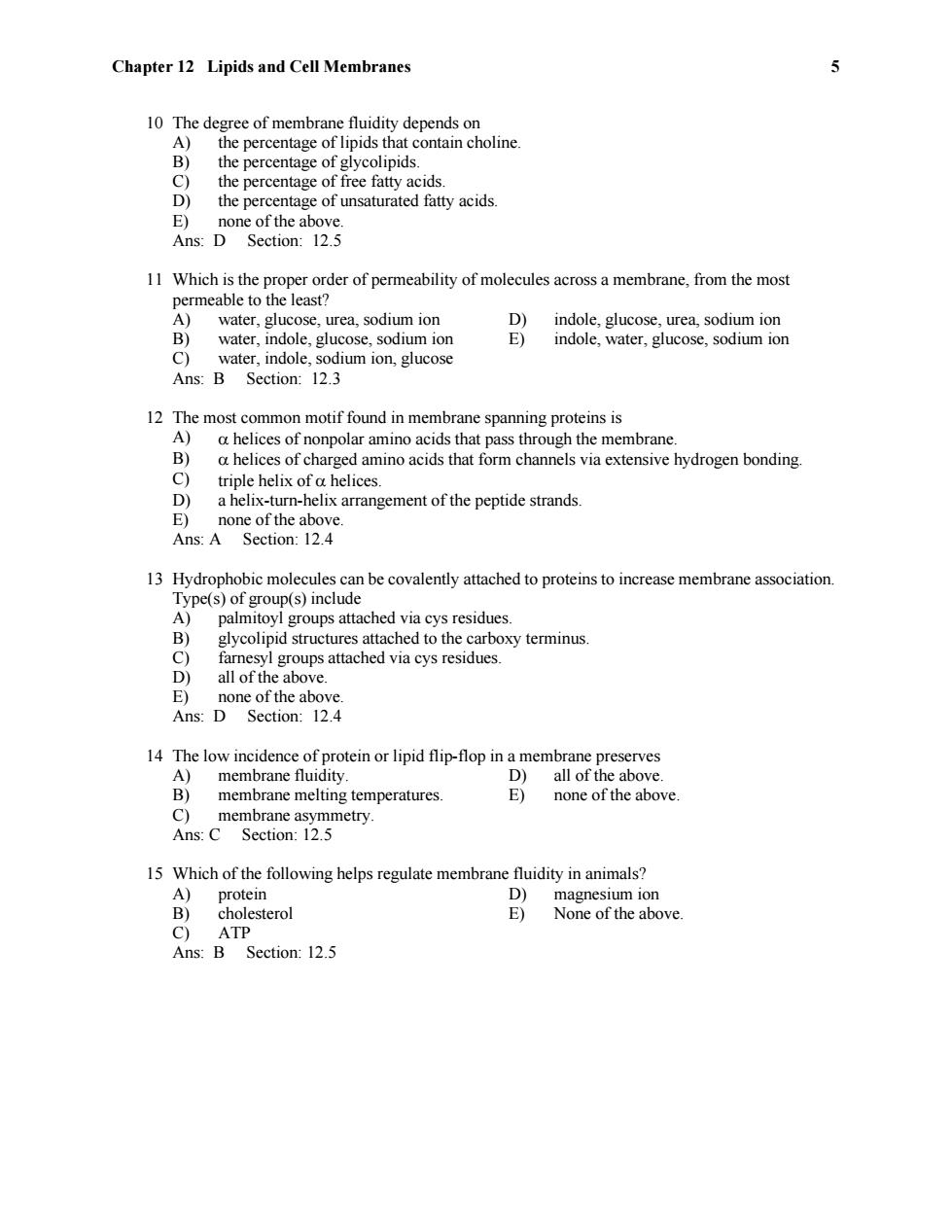正在加载图片...

Chapter 12 Lipids and Cell Membranes 10 The degree of membrane fluidity depends on A) the percentage of lipids that contain choline. B) the percentage of glycolipids C) the percentage of free fatty acids. D) the percentage of unsaturated fatty acids. E)none of the above. Ans:D Section:12.5 11 Which is the proper order of permeability of molecules across a membrane,from the most permeable to the least? A)water,glucose,urea,sodium ion D) indole,glucose,urea,sodium ion B)water,indole,glucose,sodium ion E) indole,water,glucose,sodium ion C)water,indole,sodium ion,glucose Ans:B Section:12.3 12 The most common motif found in membrane spanning proteins is A) a helices of nonpolar amino acids that pass through the membrane. B) a helices of charged amino acids that form channels via extensive hydrogen bonding. C triple helix of a helices. D) a helix-turn-helix arrangement of the peptide strands. E) none of the above. Ans:A Section:12.4 13 Hydrophobic molecules can be covalently attached to proteins to increase membrane association. Type(s)of group(s)include A)palmitoyl groups attached via cys residues B) glycolipid structures attached to the carboxy terminus. C) farnesyl groups attached via cys residues D) all of the above. E)none of the above. Ans:D Section:12.4 14 The low incidence of protein or lipid flip-flop in a membrane preserves A)membrane fluidity. D all of the above B)membrane melting temperatures E) none of the above. C)membrane asymmetry. Ans:C Section:12.5 15 Which of the following helps regulate membrane fluidity in animals? A)protein D) magnesium ion B) cholesterol E) None of the above. C)ATP Ans:B Section:12.5Chapter 12 Lipids and Cell Membranes 5 10 The degree of membrane fluidity depends on A) the percentage of lipids that contain choline. B) the percentage of glycolipids. C) the percentage of free fatty acids. D) the percentage of unsaturated fatty acids. E) none of the above. Ans: D Section: 12.5 11 Which is the proper order of permeability of molecules across a membrane, from the most permeable to the least? A) water, glucose, urea, sodium ion D) indole, glucose, urea, sodium ion B) water, indole, glucose, sodium ion E) indole, water, glucose, sodium ion C) water, indole, sodium ion, glucose Ans: B Section: 12.3 12 The most common motif found in membrane spanning proteins is A) helices of nonpolar amino acids that pass through the membrane. B) helices of charged amino acids that form channels via extensive hydrogen bonding. C) triple helix of helices. D) a helix-turn-helix arrangement of the peptide strands. E) none of the above. Ans: A Section: 12.4 13 Hydrophobic molecules can be covalently attached to proteins to increase membrane association. Type(s) of group(s) include A) palmitoyl groups attached via cys residues. B) glycolipid structures attached to the carboxy terminus. C) farnesyl groups attached via cys residues. D) all of the above. E) none of the above. Ans: D Section: 12.4 14 The low incidence of protein or lipid flip-flop in a membrane preserves A) membrane fluidity. D) all of the above. B) membrane melting temperatures. E) none of the above. C) membrane asymmetry. Ans: C Section: 12.5 15 Which of the following helps regulate membrane fluidity in animals? A) protein D) magnesium ion B) cholesterol E) None of the above. C) ATP Ans: B Section: 12.5